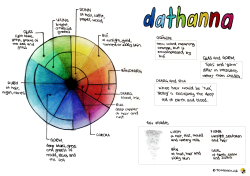Basic Color Terms
 First edition | |
| Author | Brent Berlin and Paul Kay |
|---|---|
| Language | English |
| Genre | Linguistics |
| Publisher | University of California Press |
Publication date | 1969 |
| Publication place | Berkeley, California, USA |
| Media type | |
| Pages | 178 |
| ISBN | 1-57586-162-3 |
| LC Class | P341.B4 |
Basic Color Terms: Their Universality and Evolution (1969; ISBN 1-57586-162-3) is a book by Brent Berlin and Paul Kay. Berlin and Kay's work proposed that the basic color terms in a culture, such as black, brown, or red, are predictable by the number of color terms the culture has. All cultures have terms for black/dark and white/bright. If a culture has three color terms, the third is red. If a culture has four, it has either yellow or green. (Note that this counts only the "basic" color terms. It does not include terms or descriptions such as "light blue", "carrot-colored", or "taupe". For more information, see the page on color terms.)
Berlin and Kay posit seven levels in which cultures fall, with Stage I languages having only the colors black (dark–cool) and white (light–warm). Languages in Stage VII have eight or more basic color terms. This includes English, which has eleven basic color terms. The authors theorize that as languages evolve, they acquire new basic color terms in a strict chronological sequence; if a basic color term is found in a language, then the colors of all earlier stages should also be present. The sequence is as follows:
- Stage I: Dark-cool and light-warm (this covers a larger set of colors than just English "black" and "white".)
- Stage II: Red
- Stage III: Either green or yellow
- Stage IV: Both green and yellow
- Stage V: Blue
- Stage VI: Brown
- Stage VII: Purple, pink, orange, or gray
The work has achieved widespread influence. However, the constraints in color-term ordering have been substantially loosened, both by Berlin and Kay in later publications and by various critics. Barbara Saunders questioned the methodologies of data collection and the cultural assumptions underpinning the research,[1] as has Stephen C. Levinson.[2]
One concern is whether the concept requires too much discretion when deciding what counts as a "Basic" color term, or which color divisions count as essentially the same. This raises several open questions:
Should light blue/azure be included with the stage VII color terms, even though it isn't basic in English? Is "orange" truly a "basic" term in English, and if so, is the selection of which terms are basic influenced by either the theory or historical accidents of European cultures? Are these color divisions for Gaelic or the Himba people fully compatible with the dark/light, then red, then yellow and green, then blue expectation?


See also
[edit]- Linguistic relativity and the color naming debate
- Blue–green distinction in language
- Color blindness
References
[edit]- ^ Saunders, Barbara (2000). "Revisiting Basic Color Terms". The Journal of the Royal Anthropological Institute. 6 (1): 81–99. ISSN 1359-0987.
- ^ Levinson, Stephen C. (June 2000). "Yeli Dnye and the Theory of Basic Color Terms". Journal of Linguistic Anthropology. 10 (1): 3–55. doi:10.1525/jlin.2000.10.1.3. hdl:11858/00-001M-0000-0013-2A6B-F. ISSN 1055-1360.
Further reading
[edit]- Witkowski, Stanley, and Brown, Cecil. (1977). "An Explanation of Color Nomenclature Universals." American Anthropologist, 79(1):50-57.
- Saunders, Barbara and Brakel, J. van (Jaap) (Fall 2002). "The Trajectory of Color". Perspectives on Science, 10(3):302–355.
- Saunders, Barbara A. C. (1992). The Invention of Basic colour terms. Utrecht I.S.O.R.
- Newcomer, Peter and Faris, James (October 1971). "Basic Color Terms". International Journal of American Linguistics, 37(4):270–275.
- Kay, P. and McDaniel, K. (1978). "The Linguistic Significance of the Meanings of Basic Color Terms". Language, 54(3): 610–646.
- Levinson, Stephen C. (2000). "Yélî Dnye and the theory of basic color terms". Journal of Linguistic Anthropology 10(1):3–55.
External links
[edit]- Chapter 133: "Number of Basic Colour Categories", by Paul Kay and Luisa Maff, World Atlas for Language Structures Online.
- The World Color Survey Archived 2017-11-30 at the Wayback Machine by Paul Kay and Richard Cook.
